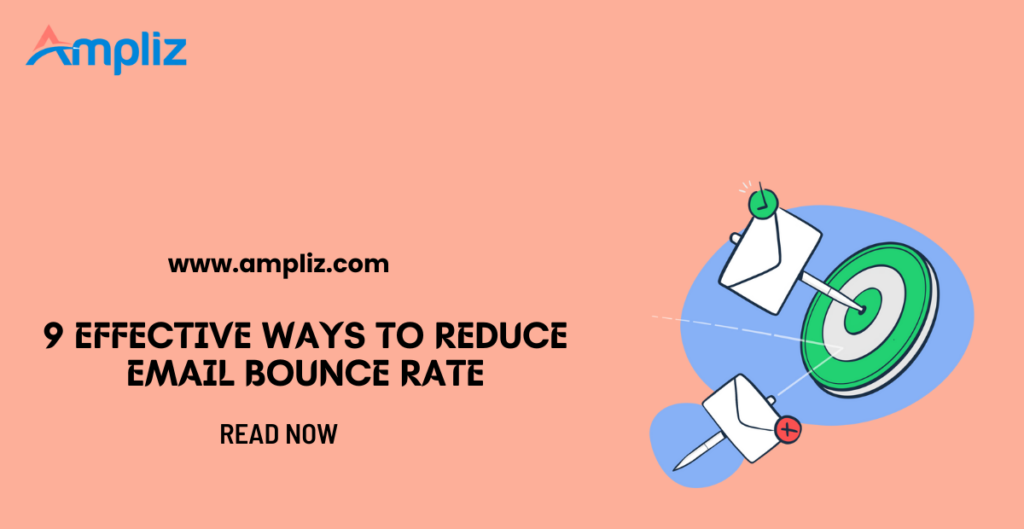Email marketing has lots of benefits to offer, so as challenges. From achieving higher deliverability, and open rates to reduce email bounce rate are some of the challenges you have to constantly deal with.
When it comes to reducing bounce rates, you must be careful from the time you collect the email address of your target audience. An accurate email address is the main cause of the bounce rate.
Because as you also know, the higher the bounce rates, the lower the deliverability. When your delivery rate itself is low, how can you accept more conversions!!
And that’s why working on reduce email bounce rate is crucial for your email marketing success.
If you too want to know how to reduce email bounce rates, then this blog is for you.
Before we discuss the ways to reduce bounce rates, let’s discuss what actually it is, what are various types, the reasons behind bounce rates, and how to measure it.
What is the email bounce rate?
Email bounce rate is the number of emails bouncing back out of the total emails you have sent. When your sent email doesn’t get delivered to its address is called a bounced email.
The more the number of bounces, the less will be the deliverability.
Bounce rate doesn’t affect only the deliverability of your email campaign but your domain reputation too. Because when you constantly get a higher bounce rate, the email marketing tool you are using will blacklist your domain.
And that’s why recognizing the reason behind the email bounce rate and putting efforts to reduce it should be done as soon as possible.
To know the various reasons behind email bounce rates, you must know the types of bounces. Let’s see what are different types of email bounces.
Types of Email Bounces
There are two types of email bounces
1. Hard bounce
The hard bounce refers to permanent email delivery failure caused by an email sent to an inactive domain or outdated domain. This happens when your subscriber stops using the email address with which they have subscribed. Sometimes the email address is faulty, like it has some spelling mistakes.
2. Soft bounce
The Soft bounce is a temporary email failure that happens when your email is very large or the recipient’s mailbox is full.
Email bounce is an inevitable part of email marketing. No matter how much you try, some bounces are bound to be there. But it has some upper limit. Like email bounce rate should not be more than 2% or you can 2% is a good email bounce rate.
With this email bounce rate formula you can check how much your email bounce rate is.
Email bounce rate = (number of bounces/Number of emails sent)*100
Now let’s see what are the reasons for higher bounce rates so that you can check them and take action in that direction.
Reasons for bounce rates.
An accurate email address is the most probable reason for email bounce but not the only one. There are many reasons that cause email bounces.
Let’s see some of them.
1. Invalid email address
When the recipient stops using the email address, or it has some spelling error the bounces occur.
2. Email server
Email delivery fails when your prospect’s email server reduces to accept the emails
3. Bad IP reputation
When your IP reputation is bad, your emails will not be delivered in to inbox of the recipients
4. Spam content
If your subject line or the main body of your email contains any spam elements, then your email will be rejected and will bounce.
Now that you are aware of different reasons behind email bounces, let’s discuss various measures which help you to avoid these incidents.
10 ways to reduce email bounce rates
1. Use permission-based email lists
The very basic thing to do to keep your bounce as well as spam rates at bay is to use permission-based email lists.
This means you should only use those email addresses for sending emails with which your prospects have subscribed to your email list. Otherwise, they will mark your email as spam and it will not reach their inbox.
Focus on the quality of your email list rather than quantity.
2. Update your email list
Collecting the email address of your prospects is not a one-time process. It’s a continuously ongoing process. You will get the maximum outcome of your email marketing efforts if you verify and update your email list at regular intervals.
As soon as you collect the email address of your prospects, you must verify it for any spelling mistakes in the email address.
You must also see that it’s an updated address.
At regular intervals you must keep on checking that email addresses are in use. If any of the email addresses is not updated then you will face the email bounce.
3. Write quality emails
Writing quality email is also a useful tip to reduce email bounce rate. Even if everything looks great in terms of a perfect email address, you will still have to face a bounce rate if you don’t write quality content. Yes, you have to write emails with which your audience can resonate.
If your audience can’t relate with your emails they find it boring and will mark it spam. This will also prevent your email from reaching the inbox and result in bounce mail.
4. Send emails regularly
You must send emails at regular intervals to keep your readers engaged remind them about you and reduce your bounce rate.. If you send emails so rarely they might forget that they have subscribed to your email address and may unsubscribe it.
Once they unsubscribe and still send them the email, they will mark your emails as spam. This will also increase your bounce rate.
5. Avoid creating spam-like emails
Using some spam-like words also prevents your emails from reaching into your inbox. If you use so many words like sale, free, or any other sales words, your email doesn’t reach the inbox of your recent.
That’s why it is important to check the content of your email before you hit the send button.
6. Don’t use a free sender domain
Study has shown that sending mail from your domain confirms the legitimate person sending mail. That’s why it’s always recommended to send the mail from your domain. This will help your mail to reach directly to the inbox before hitting the spam box.
7. Segment your audience
In the above section we saw that your mail should be relevant and of good quality. Sending relevant emails becomes easy when you segment your audience. You can segment your audience based on their demographics, geographic location, past purchase history, and so on.
Segmenting your audience will help you in personalization and writing relevant emails. And when your subscriber finds your emails relevant they won’t mark them spam and automatically your bounce rate will decrease.
4. Use a sign-up form with a good Captcha system
The biggest reason for email bounce is faulty email addresses. That’s why at the time of collection of mail itself you should check the accuracy of the email address.
One more practice that has been proven effective is using a good captcha system in sign-up forms. This will help in avoiding any robot inserting the mail address, and only real humans can enter their email address.
5. Make your Opt-ins relevant
In order to attract the right and high-quality target audience you must make your lead magnet very very relevant and full of value. Then only your target audience will not hesitate to share their right email address with you.
When they share the right email address, the chances of email bounces would be very low.
Conclusion
Email bounce has negative impact on your overall email marketing efforts. That’s why you should constantly keep a check on it and take the necessary measures to reduce it.


